Director Louie Psihoyos and an intrepid team of environmental activists risk incarceration, and more, to expose the annual slaughter of 23,000 dolphins and porpoises in Taiji, Japan. The Cove is the most riveting film you will watch from 2009.
The small Japanese town, Taiji, is a major provider of captive dolphins in the world today. Small whales, particularly the bottlenose dolphin, are captured alive and sold to various ocean parks and aquariums. There is a heated, long-standing debate on keeping dolphins in captivity for science and recreation. One faction considers it a justified sacrifice for research, arguing that such close study will yield valuable scientific data. In contrast, the group on the other end of the argument believe that the practice is inhumane and deleterious to wild populations. To the fishermen of Taiji, the captive dolphin trade is a lucrative undertaking. A dolphin alive fetches a larger profit than when it is marketed as meat.
However, the exploitation does not end there - far from it. In a hidden cove, known now as the killing lagoon, fishermen proceed to slaughter the thousands of remaining dolphins. There is no distinction: calf and adult alike are stabbed with long spears and then hauled with hooks unto waiting boats. The dolphins do not die instantly. For several minutes, they thrash painfully in the water and bleed freely from their wounds. They futilely look for an escape, suffering until the very end. The water literally runs red with blood.
For more than a decade, Japan has been proposing to abolish the international ban on whaling.
The Cove has been hailed as a thriller; a chronicle of the fearless efforts of a group of conservation warriors. But more than that, it is a piece of powerful advocacy. It is informative, discussing essential issues in cetacean conservation. For instance, it corrects the misconception that dolphins are pests to be culled in order to preserve fish stocks. An excessively large human population, not the subsistence feeding of cetaceans, is responsible for the alarming decline in fisheries. The film also provides a new fold in Japan's rejection of international whaling policies. Apparently, it is a subversive act: a people refusing to be subjugated by Western culture. The preservation of a national identity is necessary, but I seriously doubt that driving another species to extinction is the way to do it.
The Philippines itself is a hotspot for whales and dolphins. Our waters are home to twenty-four confirmed species, including the beautiful humpback whale and the acrobatic spinner dolphin. Locally, the primary threat to small cetaceans is incidental mortality. They drown, entangled as by-catch, in long lines and fine mesh nets used for fishing. The impact of these deaths on wild populations is still vague, but it is obviously harmful to small populations such as that of the extremely endangered Irrawaddy dolphin in Malamapaya Sound. The few marine mammal experts in the country have their work cut out for them, but plunge tirelessly on anyway.
The Cove focuses on dolphin conservation issues in Japan, but it reminds us all that most of the time, change cannot be affected by large conventions, but by the actions of a few very passionate and committed individuals.
P.S. Remember that news story about an emotional Hayden Panettiere at a dolphin protest? It was in Taiji. She is seen for a few seconds in the film.
Subscribe to:
Post Comments (Atom)




1 seen below:
I've never seen this film but it does look like it strikes a nerve.
Post a Comment